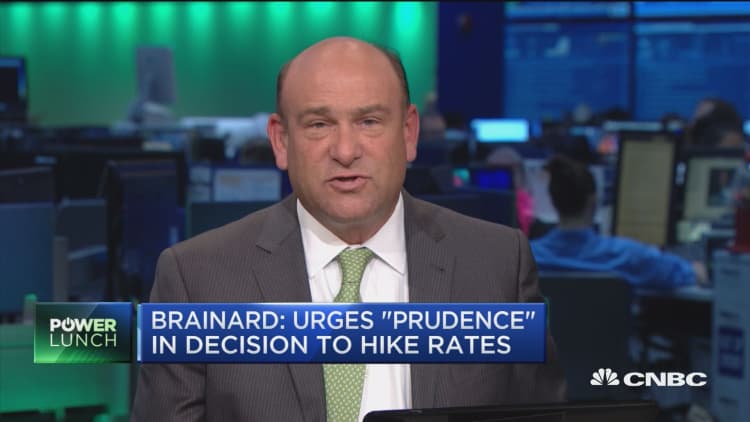
Economic progress continues in the U.S., but its central bank would be wise to continue keeping policy loose, Fed Governor Lael Brainard said in a closely watched speech Monday.
Amid market concerns that the Fed was about to resume its rate-hiking cycle, Brainard instead offered cautionary tones against moving too fast. In particular, she remains concerned about the impact that global difficulties will have on the U.S. economy.
Still-muted inflation and uncertain developments ahead "counsels prudence in the removal of policy accommodation," Brainard said, according to prepared remarks she was to deliver to The Chicago Council on Global Affairs. "I believe this approach has served us well in recent months, helping to support continued gains in employment and progress on inflation."
Chances of a rate hike at the Fed's next meeting immediately slumped after news of Brainard's speech broke. Traders now anticipate just a 15 percent probability, down from 21 percent before the speech and as high as 30 percent Friday. However, the likelihood of a move before the end of the year edged up slightly, now standing at 59.2 percent, up from 57.7 percent.
Specifically, she pointed to emerging markets and China in particular as areas of worry.
"Foreign consumption and investment are weak, while foreign demand for savings is high, along with an elevated demand for safe assets," Brainard said,
"Downside risks are also present in emerging market economies, where growth has slowed rapidly in recent years," she added. "Most importantly, China is undergoing a challenging transition from a growth model based on investment, exports, and debt-fueled state-owned enterprises to one driven by consumption, services, and dynamic private businesses. Because of the adjustment costs along this transition path and demographic trends, Chinese growth will likely continue to slow."
The remarks come amid a torrent of Fed speakers saying that at least one rate hike this year would be appropriate. The Federal Open Market Committee last enacted a rate rise in December — the first one in more than nine years.
However, the central bank has been on pause since amid concerns over the Brexit vote, uneven economic data at home, and a relatively new belief among some Fed officials and economists that a general economic malaise makes the case for aggressive rate hikes less compelling.
Perhaps most salient for monetary policy, it appears increasingly clear that the neutral rate of interest remains considerably and persistently lower than it was before the crisis.Lael Brainardgovernor, U.S. Federal Reserve
In her commentary, Brainard refers to the "new normal" of slow growth and the low level of inflation expectations. She also said there appears to be more room to grow in a labor market where headline unemployment is at 4.9 percent, but wages are growing slowly.
"In the presence of uncertainty and the absence of accelerating inflationary pressures, it would be unwise for policy to foreclose on the possibility of making further gains in the labor market," she said, adding that "disinflation pressure and weak demand from abroad will likely weigh on the U.S. outlook for some time, and fragility in global markets could again pose risks here at home."
The market was watching Brainard closely because word of her speech came as a surprise. Some traders wondered whether she may tip off a more hawkish Fed, particularly considering the most recent comments from officials and her standing as a close ideological ally of Fed Chair Janet Yellen.
However, there was little if any talk in the remarks indicating a tilt toward a sustained path of rate hikes.
Addressing the "neutral rate," or the rate needed to balance the economy, Brainard said it's probably considerably lower than the Fed previously had anticipated.
"Perhaps most salient for monetary policy, it appears increasingly clear that the neutral rate of interest remains considerably and persistently lower than it was before the crisis," she said. "To reconcile these developments, it is difficult not to conclude that the current level of the federal funds rate is less accommodative today than it would have been 10 years ago."


